
Her Voices at ‘Like Air, I’ll Rise’, Experimenter, 2024
Her Voices, an audio essay (listen here)
Her Voices (stereo 01:05:31)
Sound installation and archive
Composed by Moushumi Bhowmik with voices of women from The Travelling Archive
Edited by Arijit Mitra
Mixed by Sabyasachi Pal and Arijit Mitra at Sound of Silence, Kolkata
All field recordings by Moushumi, audio on Zoom H2N and video on Redmi Note 11, unless otherwise mentioned.
Moushumi’s narration recorded by Sabyasachi Pal.
Map by Purba Rudra
Her Voices is composed for ‘Like Air, I’ll Rise’, which is a series of conversations on care, solidarity and resistance, in this violent and broken time, amongst women artists and performers, and those who will see and listen to their work. The participating artists are Ayesha Sultana, Bani Abidi, Bhasha Chakrabarti, Emily Jacir, Jacinta Kerketta, Padmini Chettur, Sabika Abbas Naqvi, Sakshi Gupta, Sister Library, Samuho Collective, Yugantar Film Collective, and Moushumi Bhowmik.
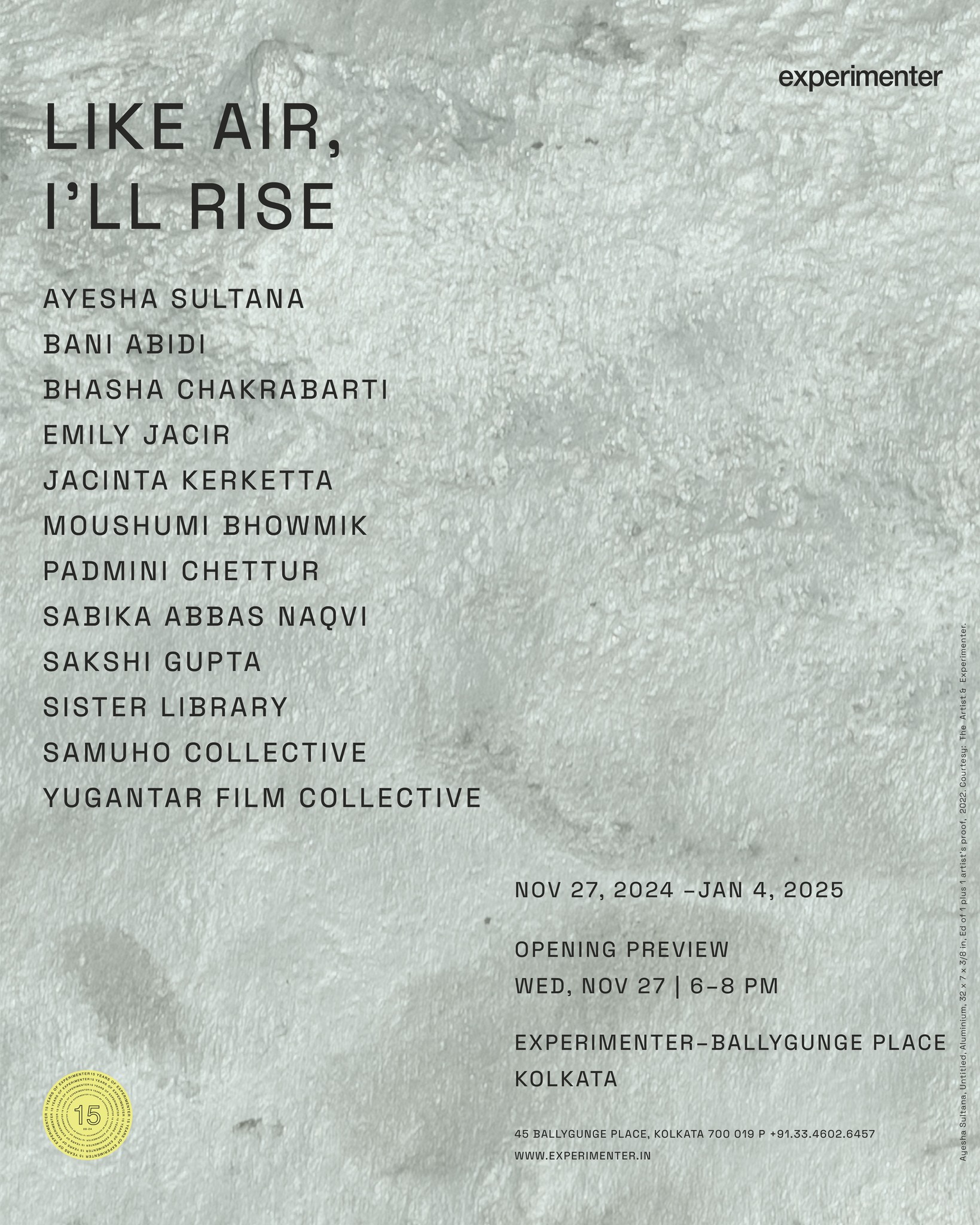
‘Her Voices’, is an audio essay, installed to play in a loop at the exhibition site, along with three audio stations and a screen with headphones for listening to the field recordings which have gone into the writing of this essay and other related sounds and images. In this essay, Moushumi journeys across a vast, fragmented and entangled land with named, nameless and unnameable women, listening to their voices and sometimes joining in with them. She keeps records of these encounters and utterances. As we listen, we travel from the archives into the future, crossing countless borders, feeling both broken and strong, within and without. Then, from the debris of life, from our everyday lives, the song rises.
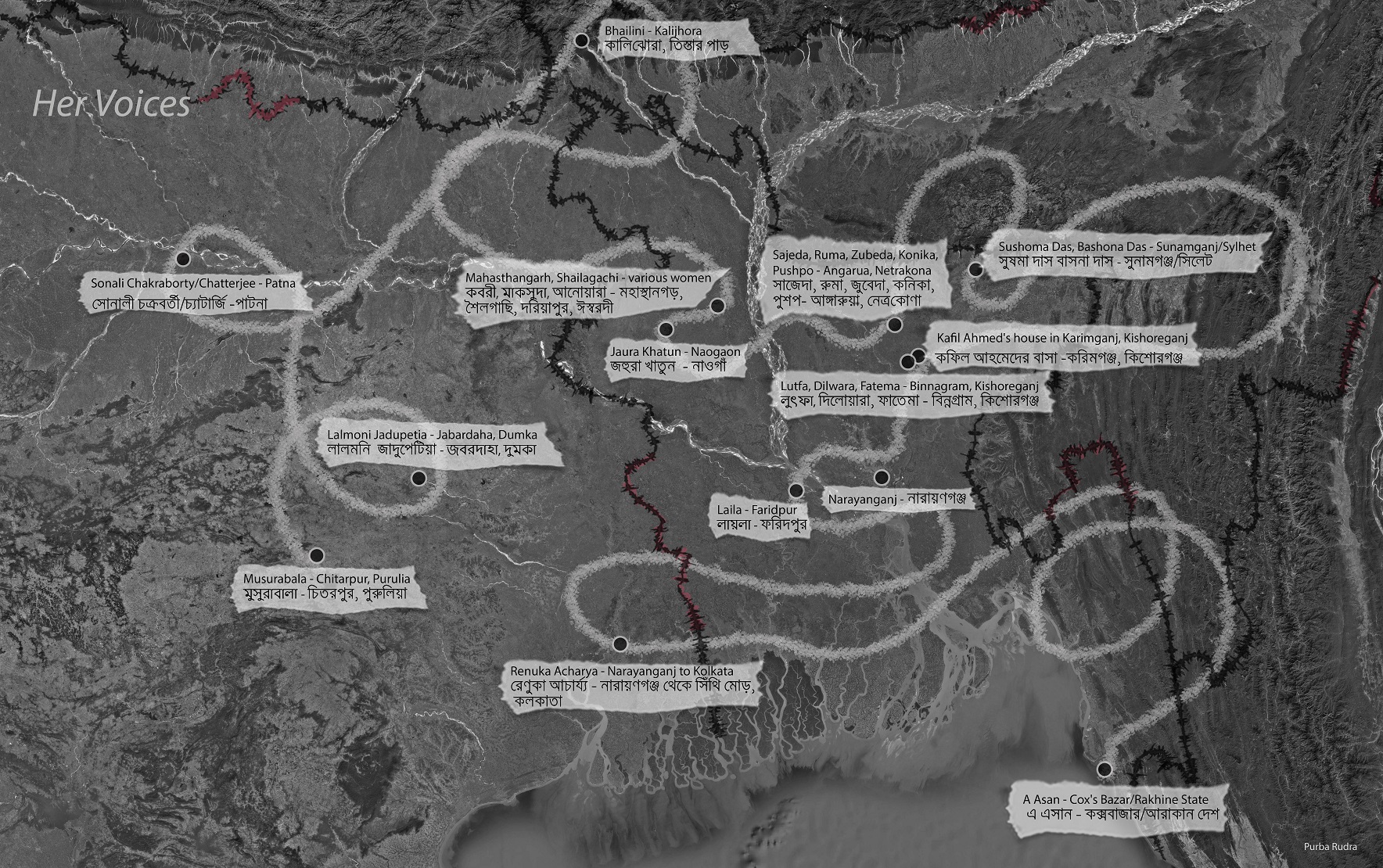
Map: Purba Rudra, 2024.
The Archive
Here we present more than the voices that appear in this audio essay. Voices are not isolated or alone, but they are part of a landscape filled with people and sounds and songs. Therefore, in the archive, we keep more than just the women’s voices; we create a context for them. And, Moushumi writes in the first person about the voices and other sounds, in order of appearance, to lay bare the structure of the essay.
Laila 2024
On 10 December 2023, Laila, a singer from Faridpur in Bangladesh, whom The Travelling Archive has been recording from 2011, called me on WhatsApp from my friend Sanjay Sikder’s mobile.



Sanjay has been a friend of The Travelling Archive since 2006 and part of our many field recording trips. Sanjay, Salamot Khan, Sayeed Masud, Milon Mahfuz Alam, Sadek Ali, Habib, Laila … they became family to The Travelling Archive. Then some departed, some were lost, while some have remained. Laila appeared that day, out of the blue and Sanjay, she and me talked about old times and Laila sang some old songs and we made plans to meet again (when, if at all, that will be, who knows?). As she talked on the phone, I turned my Zoom H2N on and recorded.
Laila 2011

Laila at Shubhunath’s tea stall with Sukanta Majumdar, Sanjay Sikder and Moushumi Bhowmik. Above the open window, on the wall, is a memorial poster for Tareque Masud the filmmaker who was killed in an accident two months ago that year. The pain was still raw. It is through Tareque that I first went to Faridpur in 2004.
This recording is from the first chance meeting of The Travelling Archive with Laila, also known as Laili and Laili Pagli. Meetings with Laila are always a matter of chance. There have been many more meetings since; we’ve been lucky. The recording session took place in Sambhunather Cha-er Dokan, in Shambhunath’s tea shop in Faridpur on 20 October 2011. That day Laila was recorded on a Zoom H4N recorder by Sukanta Majumdar. That day Habib also sang; Habib being another voice from Faridpur, very dear to us, to whom we would go back again and again.
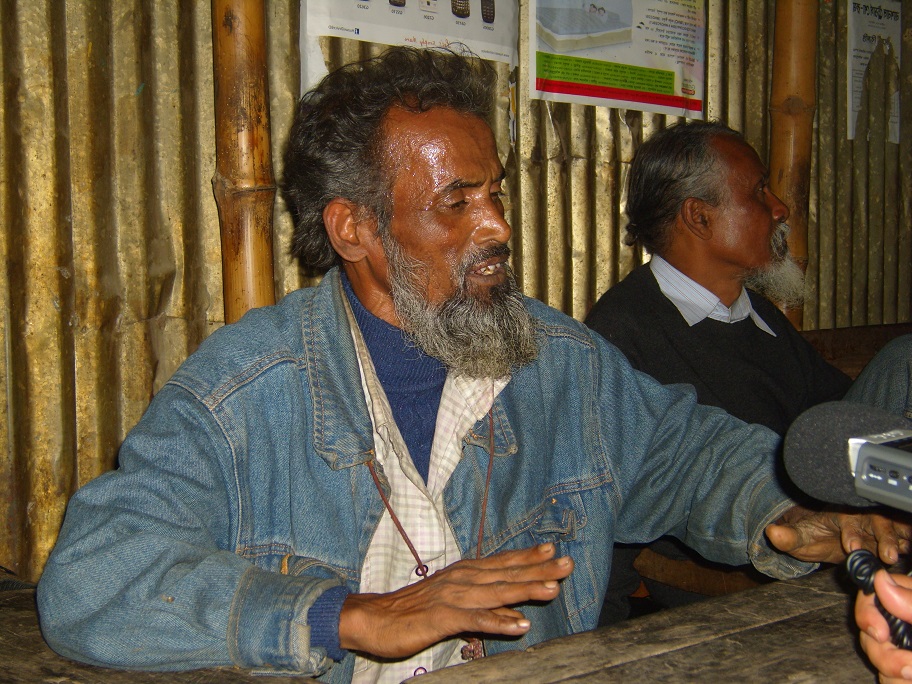
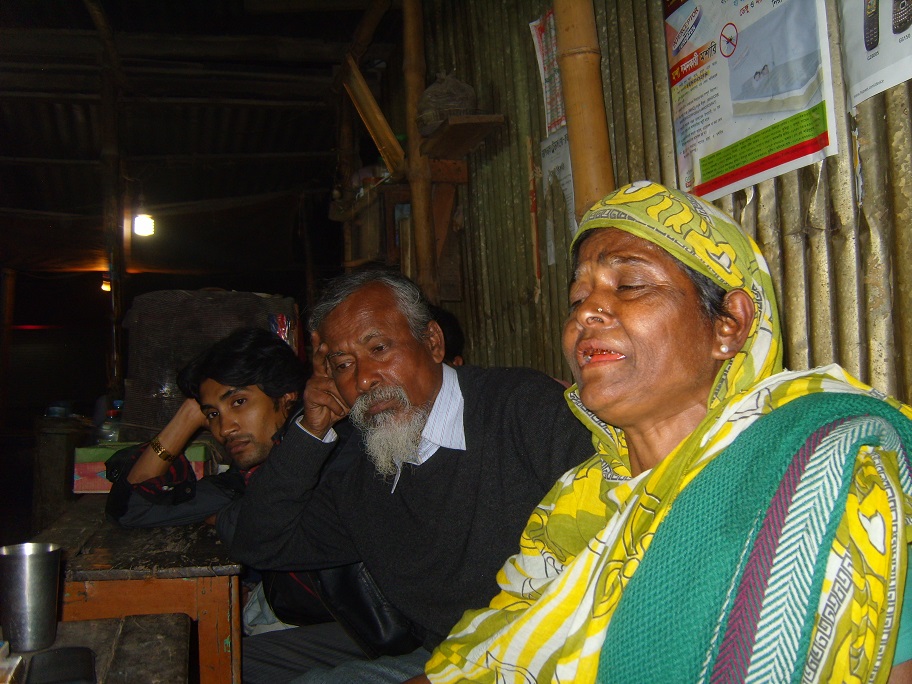
Laila and Habib, Shambhunath’s tea stall, Faridpur, 2012 (Watch video here)
Laila and Habib were at Shambhunath’s on 15 February 2012. It was the second time we were meeting Laila, in the same tea stall in Faridpur, in the company of more or less the same friends. Additionally, there were some friends from Kolkata. That tea stall is now gone, the road has become wider and there are big markets all around; it is hard to find the spot where our little tea shop, once teeming with life, used to be. Shambhuda has passed, as has Salamotbhai. We don’t know where Habib is; he was as elusive as Laila. We first met him in 2008. In 2012, the video was shot by cinematographer Pratyush Bhattacharya and the sound was recorded by Sukanta.
Blind singers
I love to record with my little recorder when I travel; trains, stations, street sellers, conversation, sounds of traffic. I feel especially drawn to singers on trains, a sound I can hear coming from a distance. I become alert and turn my recorder on. These singers are often blind. This particular recording, which has been used in this audio essay as a recurring motif, is from 20 November 2018, when I was going from Sylhet to Dhaka. Perhaps the blind woman was being led by someone, perhaps not, I cannot remember. It is not about what I saw but it is what I heard; the point is to consider how we can see and show with sound.
Here we have added one other recording of blind singers on trains from our archives.
Trains from Sylhet to Dhaka on 20 November 2018 and Kishoreganj to Dhaka 7 March 2024
The video of the pain relief balm seller in Kushtia is delightful for the street sounds I love to collect. It was recorded on 9 October 2019.
Sajeda, Ruma, Zubeda, Konika, Pushpo – Angarua, Netrokona


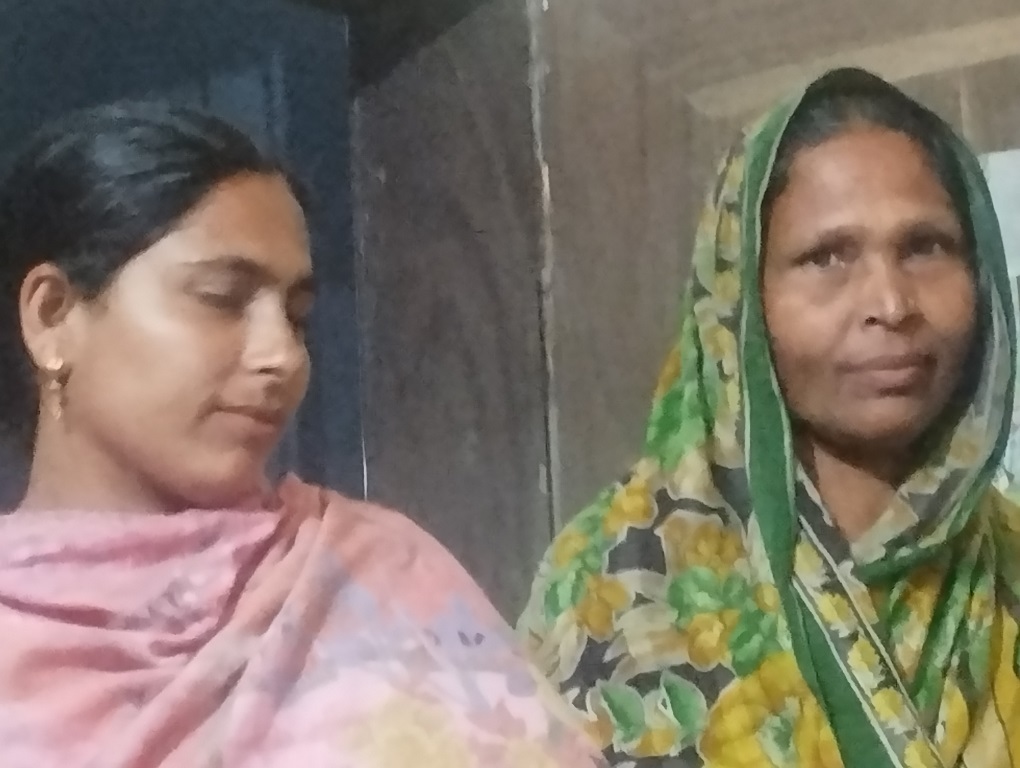

They came to meet Moushumi in Lipon’s house. 4 March 2024
They asked Moushumi to sing, and she sang.
I was in Kishoreganj and Netrakona on a field research and recording trip relating to my work on archival recordings from the First World War and a prisoner from Mymensingh in a German POW camp in 1918. I was based in the house of the singer-songwriter Kafil Ahmed in Karimganj, Kishoreganj. Accompanied by artists A Asan and Mong Mong Shay, all of us went to Bajitpur, stopping at Angarua in Kendua, Netrakona in the house of Badrun Nur Chowdhury Lipon on the way. There was music in their ‘Mongol Ghar’ or A House of Blessings. Some women of the neighbourhood came to meet me, as they had heard that I was a singer. We talked and laughed, each curious about the other. They asked me to sing for them. I sang a song I had learned from Bishu during my first trip to Purulia in 2005.
Music in Mongol Ghar, with singer Kanchan Bahari (a man of dreams), Ariful Udoy (banjo), Duddu (khol), Kanchan Pahari (flute).
Kafil Ahmed, singer-songwriter, has the power to move people and lead them on the path of collective living with humans and non-humans.
A Asan – Cox’s Bazar
Asan, a visual artist from Cox’s Bazar, belongs to the Rakhine community. Their ancestors came into this fishing port from the Arakan region of Burma, that is, from the Rakhine state in today’s Myanmar. Asan studied fine arts in Chittagong university, then went to Baroda in India for her Masters. She now lives in Dhaka. She paints stories about the cities where she has lived, about conflicts and dreams; about human and non-human lives and her own life as a woman. It was a night of deep sharing on 6 March 2024, in the house of Kafil Ahmed in Karimganj, Kishoreganj. Rezina Ahmed Shorna, a young environmental scientist, was also with us. Asan has become my sometime travel companion.
We were talking about lullabies. Shorna sang something her mother used to sing; then Asan sang one of her mother’s songs.
Lutfa, Dilwara, Fatema – Binnagram, Kishoreganj
This recording session happened on 6 March 2024, in the house of the folklorist Mohammad Saidur in Binnagram, Kishoregan . His son, Haresuzzaman Hares, has been helping me in my research in so many ways. Since I wanted to find out about puthi path or melodic reading in the Kishoreganj/Netrokona area, comparing it with the fragmented puthi recording I had from 1918, Haresbhai asked me to come home. He had arranged for me to meet some puthikars, but also thought it would be good for me to listen to some local women’s geet (since Kishoreganj is also the home of Chandrabati , considered the first woman poet of Bengal, who wrote an unfinished interpretation of the epic Ramayan from Sita’s perspective).
So, there was Lutfa, Dilwara and Fatema in Haresbhai’s courtyard. They sat close and sang, forming a circle, almost womblike, while we formed an outer circle of listeners and recordists around them.

Circles of singing, listening and recording. Photo by A Asan.
Lutfa, Dilwara and Fatema sing a beautiful song about the paraphernalia of weddings, such as mehendi or henna, holud (turmeric), paan (betel leaf) and shupari (betel nut)
Bhailini girls– Kalijhora
In November 2018, I went with Sophie Mckeand, a poet from Wales with whom I was working on water sounds, on a trip to Sikkim and North Bengal, travelling along the course of the Teesta River. We were being guided and accompanied on this journey by my trade unionist friends from the region, Samik and Chewang. On 7 November, we reached the house of Umesh Pariyar, a local journalist and activist. It was the time of Tihar, one of the most important festivals of the Nepalis. At night the girls of Umesh’s house were singing ‘bhailo’ songs to usher in Lakshmi, the goddess of prosperity and wellbeing.
Groups of girls go from house to house singing songs and collecting money and sweets on new moon night of Lakshmi puja. Amid the fireworks, chattering and recorded songs coming out of loudspeakers, the girls’ song rises and falls, near and far.
Next day it is turn of the boys. And they sing their deusi songs with great enthusiasm. Recorded in Kalijhora on 8 November 2018.
Renuka Acharya – Narayanganj/Kolkata
When Renuka Acharya died in her home in north Kolkata at 79 years in 2010, no one outside her close circle of family and friends took notice of her passing. She was as obscure in death as she was in life. Yet here was a woman artist who had silently composed hundreds of devotional songs, mainly to goddess Kali, and could sing as beautifully till almost the end of her life. The grind of everyday life, a house full of children, domestic responsibilities—nothing could deter her; as if she was compelled to write and sing. She was recorded at home one evening, possibly around 2006, on a microcassette recorder, by one of her sons. The primary initiative came from one of her daughters-in-law, who bought the equipment during a trip abroad, with the sole intention that this extraordinary woman must be recorded. The Travelling Archive chanced upon these tapes through a personal connection and they were digitised by Sukanta Majumdar. The song quoted in this audio essay was part of a record entitled The Travelling Archive: Folk Music from Bengal, which was produced by Robert Millis and released by Sublime Frequencies in 2014.
Here is another beautiful song composed and sung in the quiet of old age, at home, by Renuka Acharya. ‘I don’t know who you are, I don’t want to know, All I know that you are my merciful mother.’
Jaura Khatun – Home unknown

Panel from Time Upon Time exhibition 2015
This is a wax cylinder recording from February 1932, made by the Dutch ethnomusicologist Arnold Bake in Naogaon in the Rajshahi region of Bangladesh. I was given a copy by the Berlin Phonogramm-Archiv when I was working on my doctoral research on Bake’s Bengal recordings . For some years I was moving round and round through places with this voice and the archival note attached to it, as in the gyrating motion of a cylinder, in the hope of finding a home for Jaura. But I still haven’t found one. So, who was Jaura Khatun? I don’t know. Then, what do I know after all these years of looking?
Jaura Khatun was recorded by Arnold Bake in Naogaon on 28 February 1932. Recording courtesy: Berlin Phonogramm-Archiv. ‘Prem koro mon, premer marma jene (Love, O heart, knowing what love is worth / It is no easy game/ Learn to seek and find your guru.)’ Bake recorded the sound and kept a record of the name of the singer; the writer Annada Sankar Ray, who was present at the recording and folksong collector and author Mahammed Mansooruddin, who had facilitated the recording, also wrote about Jaura. Yet, she has no home.
Why did women like Jaura leave home with the song in their hearts? Or were they forced by their circumstances to leave home and then the song became their refuge? Women such as Kabari Dewan of Shailagachi, also in the Naogaon region, might have an answer to the question.
Kabari
Kabari Dewan is a woman I met on my search for Jaura Khatun. Why did you choose this path, I asked her. This was on 26 November 2018, almost nine decades after Jaura was recorded by Bake. Kabari said, ‘From when I was small, you know, I had such a passion for music! But it was not easy. They kick your ass, kick again, but you don’t give up, you keep trying. Then I found him, he was my tree in whose shade I stood. Sadly, my fate was against me. He died, then my daughter died, within months of one another. Now there’s none.’ When I was going back to Naogaon in 2019, I called Kabari. She said, ‘Ah Daradi (O my caring friend!). I don’t live there anymore. But do come and see me.’ Others said she had moved in with someone near Rajshahi town.
It was on 26 November 2018 that Kabari delivered this ‘monologue’ on grief and loss. The images accompanying her voice are stills from our first field trip to Naogaon in 2015. The video was made by Sukanta Majumdar in 2019.
Listening to Musurabala with Amulya Kumar
Musurabala , a nachni of Kotshila, Chitarpur in Purulia district, had sung the song ‘Kasio phool’ in a local dialect way back on 28 November 2005. We went to meet her with the senior practitioner of jhumur, Amulya Kumar (Amulya Kaka). I had to wait for many years before I could start to understand the words of this song in which the seasons go by while the homesick girl waits for someone to come from her naihar or natal home.
This recording of a listening session is from my home on 19 June 2023, when Kaka had come to visit. He kept saying that these are women’s songs and men don’t sing them. I kept insisting that he sing me some women’s songs, which he actually did.
I met Kaka for the first time in 2005 and now he has become like a father and guru to me
Writing down the words of Musura’s song (extract), 19 June 2023, Kolkata
Moushumi Bhowmik and Ben Heartland – ‘Ghum Aay’ based on ‘Kasio Phool’
In 2010, I worked with Oliver Weeks on the 2010 play ‘Walking to the Sun’ directed by Sunil Shanbag for Prithvi Theatre, Mumbai. The play was based on Rabindranath Tagore’s Dakghar (The Post Office) and the story of the Polish paediatrician Janusz Korczak. I composed a lullaby, ‘Ghum Aay’, taking the melody of Musurabala’s ‘Kasio Phool’.
I recorded my voice at home in Kolkata; I was recorded by Sukanta Majumdar. Ben Heartland played bass in London. The music was later mixed in Kolkata.
Ghum Aay by Moushumi Bhowmik and Ben Heartland
Lalmoni Jadupetia
From 13-16 January 2024, I was in Jabardaha village in Jharkhand, eastern India, with the artist Alok Roy and my friend, Purba Rudra, in the home of some dokhra artists who work with scrap metal using the lost wax method of sculpting and make bells and anklets, ghungur and paigan, and other beautiful things such as animals and birds, pots to measure rice, bangles and toe rings and so on. I had heard about their practice from Alokda, and wanted to go because I was curious to listen to a whole village pulsating with the sound of new bells; the jingle of freshly-made ghungur. Placing my recorder on the ground, and making video recordings with my phone, I listened and watched with wonder as Nizam, Lalmoni, Mukim, Nabijan, Nayatun and even little Munnu made the bells with wax and clay and scrap metal through a long, complex and intricate process. They chatted and laughed and discussed urgent matters as they took out the red hot, clay-filled clusters of little bells from the furnace, which looked like the inside of an aataa fruit or custard apple. Then that whole family of dokhra artists, from grandmother to small grandchildren, separated, cleaned and shook the bells in a basket; they shook them hard, till their bellies were hollowed out and the balls inside started to move. In that jingling sound, earth fire and air seemed to come together. As they worked, I asked the matriarch, Lalmoni Jadupetia about their songs. She laughed and sang. Later at night we sat around the fire and told stories and there were more songs.
Lalmonidi works with deft fingers on each little bell. This video was recorded by Purba on 13 January 2024.
And here, on the morning of 14 January 2024, Lalmonidi was giving lessons to Purba about how to listen for the right sound of the bells; which bells are good and which must be rejected. These can be interpreted as much more than mere lessons in the craft of bell-making.
Nightfall: Sushoma Das,
It is now almost twenty years since I first met Sushoma Das in Sylhet in 2006. She was 76 then, now she is 94. I called her on 31 October 2024, and we talked. She is not keeping well, she said. Then she sang a song, I recorded her on the phone.
Her breath, tonal perfection and memory never ceases to amaze me. The line is cracking up. Some words are getting lost. But I had to keep a record of this conversation.
Sushoma Mashima eternally shades us. We have many recording sessions with her but it never feels enough. I fear losing her, which will inevitably happen. When I called her on 31 October, she told me that she was not being able to rest her head on the pillow or comb her hair. Everything hurts, she said. I suppose it hurts inside and out. How does a mother deal with her daughter leaving before her? It was to distract her that I said, will you sing me a song? And she did. She sang her one of her own compositions, a song about leaving this world. Yet, from 2006, when we met for the first time till now, Sushoma Das remains a strongest presence in the life of The Travelling Archive.
Waiting for the Song, Sonali Chakraborty/Chatterjee
Her whole story is on the audio essay, and the song that she is looking for. She came to us through an article I had written in AnandaBazar Patrika on a song of Nabani Das Baul, that I had found in the archives of the British Library. She came to ask if we could find her a song that she was looking for. There is not much else to add. Except for the song Sonali Chakraborty/Chatterjee’s friend Sarmishtha Chatterjee had recorded; she sang a sample of that and sent to me over the phone on 29 December 2023. Sarmishtha was recorded under the same circumstances as Sonali, same day, same place. Therefore, 1982. Ravi Bharti studio, Notre Dame School, Patna. Recorded by Brother Vijay. Song composed by Sudipto Das.
We keep these songs in our archive, in the hope that someday we will be able to find Sonali’s original recording for her.
- Rehearsals for Revolution at Serendipity Art Festival, 2024
- Baba Betar at Chobi Mela Shunyo 2021
- A Slightly Curving Place 2020
- Chobi Mela Biennale, 2019
- Time upon Time: Arnold Bake in Bengal 2016
- Baul Fakir Utsav 2006-2015
- Travelling Archive in East London 2015
- Footsteps of Sound 2013
- Unbox 2013
- Life of Rivers, 2011
